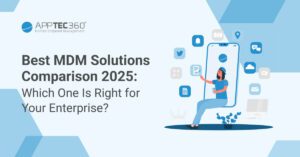Managing devices in the enterprise has never been more complex. With the rise of hybrid work, BYOD policies, and various operating systems in use, IT teams feel constant pressure to keep endpoints secure and compliant without hindering operations. That’s where Mobile Device Management (MDM) comes in.
But, in 2025, it’s no longer just about traditional MDM. Enterprises now seek the best MDM software that combines Unified Endpoint Management (UEM), Enterprise Mobility Management (EMM), and real-time control over every device, including laptops, smartphones, and digital signage.
In this ultimate guide to Mobile Device Management (MDM), we will explore how businesses can effectively manage modern endpoints in 2025. You will discover what MDM means today, how it has changed with Unified Endpoint Management (UEM) and Enterprise Mobility Management (EMM), and why it has become an essential part of every IT strategy.
Get a free trial of our MDM solution for up to 25 devices and see how easy managing your mobile ecosystem can be.
TL; DR
This guide is for IT managers, sysadmins, and enterprise decision-makers who want to implement or upgrade their MDM solution in 2025. It covers features, comparisons, best practices, and future trends in Mobile Device Management.
Here’s what you’ll learn:
- How Mobile Device Management (MDM) has changed to meet today’s hybrid and remote work demands
- What features to expect from the best MDM software in 2025 for complete device control
- How leading MDM solutions compare, and which ones fit different business needs
- The biggest challenges enterprises face with MDM and how to solve them effectively
- Proven strategies to implement MDM successfully without disrupting operations
- Discover where MDM is headed in 2025 for key trends, innovations, and what they mean for your enterprise strategy.
What is Mobile Device Management (MDM)?
Mobile Device Management (MDM) is a group of software and policies that organizations use to monitor, manage, and secure mobile devices like smartphones, tablets, laptops, and desktop systems. It gives IT administrators centralized control over device settings, security enforcement, application installation, and data access.
Why MDM Matters More Than Ever in 2025
With more distributed teams, personal devices in the workplace, and increasing cyber threats, modern endpoint management is essential for digital operations.
Here’s why MDM is critical in 2025:
- Device Diversity: Companies have to manage a variety of iPhones, iPads, Androids, Windows laptops, and even kiosks or ChromeOS MDM setups.
- Security & Compliance: MDM provides data encryption, policy enforcement, and real-time compliance with regulations like GDPR and HIPAA.
- Operational Control: From retail POS tablets in kiosk mode to devices for field teams, centralized MDM enhances visibility and control.
- Employee Productivity: Smooth app deployment, updates, and access management help users stay focused; they won’t be held back by IT issues.
As workforce models change and UEM software becomes smarter, MDM serves as the foundation of secure, flexible IT environments.
The Evolution of MDM
MDM started as a tool to manage employee smartphones. Today, it’s evolved into a comprehensive enterprise solution that integrates with Unified Endpoint Management (UEM) and Enterprise Mobility Management (EMM) platforms.
Key shifts in MDM over the years:
Then: Focused on managing company-issued smartphones only
Now: Supports BYOD, COPE, and COBO policies across multi-OS fleets (iOS, Android, Windows, macOS, ChromeOS)
Then: Basic device lockdown and app blocking
Now: Includes app management, kiosk mode, digital signage, location tracking, and more
Then: IT-led remote configuration
Now: Real-time policy enforcement, compliance audits, and integrations with Apple ADE, Apple School Manager, and Android Enterprise
This evolution allows modern MDM solutions to function not just as control tools, but as productivity enablers across enterprise environments.
Key Features and Capabilities of Modern MDM Solutions
Modern MDM solutions extend well beyond basic device tracking. Today’s enterprise tools provide centralized control, improved security, and smooth integration with wider IT systems, making them vital for managing various distributed endpoints.
Here’s a breakdown of the key abilities to expect from the best MDM software in 2025:
1. Device Enrollment & Provisioning
Quick and secure onboarding is the first step to effective endpoint management.
- Support for zero-touch provisioning through Apple ADE, Android Enterprise, and Windows Autopilot
- Bulk enrollment for corporate-owned and BYOD devices
- Automated setup of settings, restrictions, and apps right from the start
This simplifies setup across operating systems like iOS MDM, macOS MDM, Windows MDM, and ChromeOS MDM.
2. Security Policies & Compliance Management
With rising threats and regulations, security needs to be proactive and enforceable.
- Enforce passcodes, encryption, VPN, and Wi-Fi settings
- Enable remote wipe for lost or stolen devices
- Ensure compliance with GDPR, HIPAA, and enterprise audit standards
- Real-time alerts and policy enforcement through UEM software
Modern MDM tools serve as frontline security for enterprise data and employee privacy.
3. App Management & Updates
Control over apps is critical for productivity, security, and performance.
- Push and manage apps via Apple VPP and managed Google Play
- Enable silent installation, update scheduling, and license tracking
- Restrict unauthorized apps and automate updates across device groups
This feature is particularly valuable in COPE and corporate-owned device environments.
4. Remote Monitoring & Troubleshooting
IT teams need complete visibility into every device, regardless of its location.
- Real-time dashboards for device health, status, and compliance
- Remote actions such as lock, wipe, restart, or send messages
- Integrated troubleshooting tools for quicker issue resolution
This reduces downtime and boosts IT efficiency, especially for global teams.
5. Integration with Other IT Systems
Modern MDM is not isolated; it connects with the broader IT framework.
- Seamless integration with identity providers like Azure AD and LDAP
- Compatibility with EMM platforms, helpdesk tools, and SIEM systems
- APIs for linking with asset management or HR systems
This positions MDM as a foundational part of digital workplace infrastructure.
These features empower organizations to scale securely, cut down on manual tasks, and ensure full control over every device, from Apple Classroom iPads to Android kiosks and digital signage units.
Comparison of the Best MDM Solutions in 2025
Choosing the best MDM software isn’t a one-size-fits-all decision. It depends on your device mix, security needs, deployment model, and budget. In 2025, the MDM landscape is led by providers that offer strong features, platform flexibility, and smooth integrations with enterprise systems. To help you narrow down your options, here’s a quick look at the top MDM solutions used by enterprises today.
Top MDM Providers in 2025 (At a Glance)
MDM Solution
OS Support
Key Strengths and Ideal For
AppTec360
iOS, Android, Windows, macOS
Cost-effective, strong EU compliance
Ideal For: SMEs, GDPR-focused enterprises
Microsoft Intune
Windows, iOS, Android, macOS
Deep Microsoft integration, endpoint security
Ideal For: Microsoft-based environments
VMware Workspace ONE
Windows, macOS, iOS, Android
Unified UEM platform, automation
Ideal For: Large-scale enterprises
Jamf Pro
iOS, macOS
Apple ecosystem management
Ideal For: Education, Apple-first companies
Cisco Meraki SM
iOS, Android, macOS, Windows
Network integration, simple UI
Ideal For: Mid-sized businesses
IBM MaaS360
All major platforms
AI integration, strong reporting
Ideal For: Compliance-heavy industries
Do you want a deeper comparison? Head over to our full breakdown:
Best MDM Solutions Compared 2025: Which One Is Right for Your Enterprise?
This detailed guide dives into pricing, deployment models, use-case fit, and more – helping you compare top MDM tools feature-by-feature.
Common MDM Challenges in 2025 and How to Solve Them
Even the best MDM software faces challenges. As enterprise environments become more complex, IT teams manage a mix of platforms, policies, users, and compliance needs while trying to maintain visibility and control.
Here are some common challenges businesses encounter with Mobile Device Management in 2025 and how to address them effectively:
1. Device Diversity and OS Fragmentation
- Supporting Android MDM, iOS MDM, Windows MDM, macOS, and ChromeOS MDM under one policy framework is not easy.
- Each platform has its own quirks, permission models, and provisioning methods (think Apple ADE, Android Enterprise, etc.).
What helps: Choose a cross-platform UEM solution that centralizes policy enforcement and allows OS-specific configurations without separate tools.
2. User Resistance and BYOD Pushback
- Employees resist when BYOD feels intrusive, especially when personal data exists on managed devices.
- Poor communication about COPE policies can lead to low adoption or shadow IT behavior.
What helps: Use UEM tools that include containerization, clear privacy policies, and opt-in enrollment flows. Educate users about what is managed and what isn’t.
3. Evolving Security Threats
- Mobile endpoints are increasingly targeted by phishing, ransomware, and data leaks, often outside the company firewall.
- Compliance with frameworks like GDPR or HIPAA becomes trickier with remote and hybrid teams.
What helps: Select MDMs that support real-time compliance alerts, remote wipe, data encryption enforcement, and role-based access. Integration with SIEM systems and identity platforms like Azure AD is a plus.
4. Scalability and Management
- Overhead Managing thousands of endpoints across teams, locations, and device types can lead to large manual workloads.
- Some legacy tools do not scale well or lack automation for routine tasks.
What helps: Look for MDM solutions that offer bulk actions, smart groups, automated workflows, and strong API support for integration with HR or helpdesk systems.
Read our complete breakdown of real-world issues and tested solutions: Top MDM Challenges in 2025 and How to Solve Them
Best Practices for Successful MDM Implementation
Implementing a Mobile Device Management (MDM) solution is not just a technical rollout; it’s an operational shift. To get it right, organizations need to synchronize policies, platforms, user needs, and security goals. Whether you’re deploying Android MDM, Apple MDM, or a full UEM strategy, these best practices will help ensure long-term success.
1. Start with a Clear Policy Framework
Before deploying any tool, define your usage policies. Clarify what is allowed under BYOD, COPE, or COBO models. Will you allow personal devices? What data can IT access or wipe? What restrictions apply to corporate devices? A well-defined policy, coordinated with HR and legal, builds clarity and trust.
2. Group and Segment Devices Intelligently
Organize devices based on OS, location, department, or ownership type. Grouping makes it easier to assign profiles, push apps, or apply specific restrictions. For example, Apple ADE-enrolled devices might follow a different compliance policy than Android COPE devices used in the field.
3. Automate Enrollment and Provisioning
Manual setup wastes time and increases the chance of errors. Use zero-touch enrollment tools like Apple ADE, Android Enterprise, or Windows Autopilot to pre-configure devices with Wi-Fi, VPN, apps, and restrictions. This reduces onboarding time and ensures consistency.
4. Centralize App Management
Apps can be a major security risk if unmanaged. Use Apple VPP and Managed Google Play to control what gets installed. Push business-critical apps silently, block unwanted ones, and schedule updates during non-working hours. Tie app access roles and automate license tracking.
5. Ensure Strong End-User Communication
One of the biggest blockers in MDM adoption is user resistance, especially in BYOD scenarios. Explain what MDM can and can’t access, and how it benefits users, such as security, remote support, and faster provisioning. Transparency improves trust and adoption.
6. Monitor, Audit, and Iterate
Implementation isn’t a one-time task. Use dashboards to monitor device health, compliance status, and app usage. Run regular audits. Look at reports from your UEM or EMM software and identify gaps in policy or trends in user behavior. Adjust policies accordingly.
7. Integrate with the Larger IT Ecosystem
Your MDM shouldn’t work in isolation. Integrate it with your identity provider like Azure AD, helpdesk systems, and SIEM tools. This streamlines IT workflows and enables automated responses to incidents like compromised devices or policy violations.
A successful MDM implementation balances control with user experience. With the right strategy, you not only secure your endpoints; you also reduce IT overhead, support scalability, and prepare for future workplace demands.
Who Should Use This Guide?
This guide is designed for:
- IT managers and system administrators manage large groups of devices across Android, iOS, Windows, or mixed environments
- CIOs and technology decision-makers who are planning secure BYOD or COPE strategies for global teams
- Enterprises in Europe that need GDPR-compliant MDM solutions with support for data sovereignty
- Education and retail Teams interested in device lockdown, Apple School Manager, or Kiosk Mode rollouts
- Organizations that are scaling remote or hybrid workforces and need visibility and control across every endpoint
If you are evaluating or upgrading your MDM solution, this guide and AppTec’s platform address your challenges.
The Future of MDM: Trends & Innovations in 2025
Mobile Device Management is no longer just about locking down phones. It’s becoming a smarter part of enterprise infrastructure. In 2025, the shift toward Unified Endpoint Management (UEM) is speeding up. Organizations want one platform to manage everything, including laptops, smartphones, tablets, digital signage, kiosks, and even wearables.
AI-driven automation is also changing MDM. Expect smarter compliance alerts, automatic fixes, and predictive insights across Apple MDM, Android Enterprise, and Windows MDM fleets. Zero Trust security models are becoming the standard. MDM tools now need to work with identity providers, enforce context-aware access, and support real-time threat responses.
Meanwhile, niche use cases are on the rise, such as Apple Classroom, Apple School Manager in education, and Kiosk Mode in retail or logistics. Looking ahead, modern MDM solutions will keep blending into the larger Unified Endpoint Management (UEM) ecosystem. They will focus less on control and more on agility, integration, and user-friendly design.
Wrap Up
Modern Mobile Device Management is more than securing endpoints — it’s about enabling productivity, simplifying IT operations, and staying compliant in a dynamic digital world. With evolving needs around BYOD, COPE, cross-platform support, and real-time security, investing in the best MDM solution is critical for future-ready enterprises.
Looking for a customized solution? Explore our MDM services or contact our team to discuss how we can help secure your mobile environment in line with modern challenges.
FAQs
1. What should I look for in an MDM solution for 2025?
Look for support across platforms like iOS, Android, Windows, and ChromeOS. Make sure it meets GDPR requirements, offers app management, remote control, and automation features. The blog outlines the essential capabilities and how to choose the right tool for your business needs.
2. How do top MDM solutions compare to EU-based businesses?
Solutions like AppTec360, Intune, and VMware Workspace ONE vary in pricing, deployment options, compliance focus, and platform support. Our blog includes a comparison table and links to a detailed MDM comparison guide for more insights.
3. What are the biggest MDM challenges in 2025?
Common challenges include device diversity, BYOD complexity, user resistance, and enforcing compliance. The blog explains each issue and how to address them with the right tools and policies.
4. How can I implement MDM in a scalable and secure way?
Start with clear policies and automate enrollment using Apple ADE or Android Enterprise. Integrate it with your existing IT systems. Our best practices section guides you through the steps to ensure a smooth rollout.
5. Is MDM still relevant, or should I move to the UEM?
MDM is still a key part of endpoint security, but many businesses are moving to Unified Endpoint Management (UEM) for greater control. The blog looks at this shift and what it means for companies in 2025.



